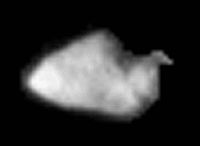5535 Annefrank

5535 Annefrank viewed by Stardust in 2002
|
|
| Discovery | |
|---|---|
| Discovered by | K. Reinmuth |
| Discovery site | Heidelberg Obs. |
| Discovery date | 23 March 1942 |
| Designations | |
| MPC designation | 5535 Annefrank |
|
Named after
|
Anne Frank |
| 1942 EM · 1978 EK6 1986 TV14 · 1991 BO2 |
|
| main-belt · Augusta family | |
| Orbital characteristics | |
| Epoch 13 January 2016 (JD 2457400.5) | |
| Uncertainty parameter 0 | |
| Observation arc | 26726 days (73.17 yr) |
| Aphelion | 2.3533 AU (352.05 Gm) |
| Perihelion | 2.0722 AU (310.00 Gm) |
| 2.2127 AU (331.02 Gm) | |
| Eccentricity | 0.063522 |
| 3.29 yr (1202.2 d) | |
| 203.56° | |
| 0° 17m 57.984s / day | |
| Inclination | 4.2474° |
| 120.65° | |
| 8.9074° | |
| Earth MOID | 1.08715 AU (162.635 Gm) |
| Jupiter MOID | 2.66314 AU (398.400 Gm) |
| Jupiter Tisserand parameter | 3.650 |
| Physical characteristics | |
| Dimensions | 4.8 km (6.6 x 5.0 x 3.4 km) |
|
Mean radius
|
2.4 km |
| 15.12 h (0.630 d) | |
|
Sidereal rotation period
|
Multiple possible values |
| 0.18–0.24 | |
| S | |
| 13.7 | |
5535 Annefrank /ˌæn ˈfræŋk/ is an inner main-belt asteroid, and member of the Augusta family. It was discovered by Karl Reinmuth at Heidelberg State Observatory in 1942. In 1995 it was named after Anne Frank, the Dutch-Jewish diarist who died in a Nazi concentration camp (World War II). The asteroid was used as a target to practice the flyby technique that the Stardust space probe would later use on the comet Wild 2.
Annefrank orbits among the main-belt asteroids, with its shortest axis aligned roughly normal to its orbital plane.
On November 2, 2002, the Stardust space probe flew past Annefrank at a distance of 3079 km. Its images show the asteroid to be 6.6 × 5.0 × 3.4 km, twice as big as previously thought, shaped like a triangular prism, with several visible impact craters. From the photographs, the albedo of Annefrank was computed to be between 0.18 and 0.24. Preliminary analysis of the Stardust imagery suggests that Annefrank may be a contact binary, although other possible explanations exist for its observed shape.
...
Wikipedia
